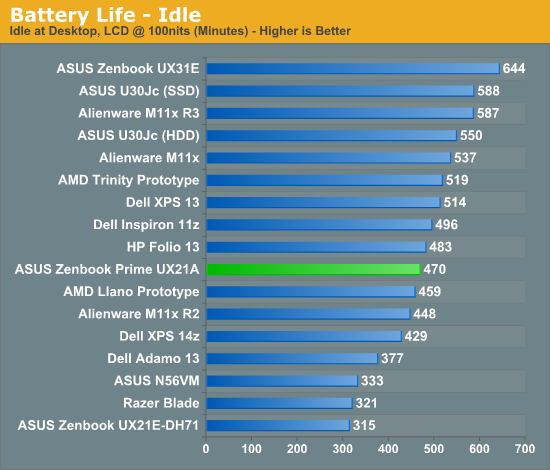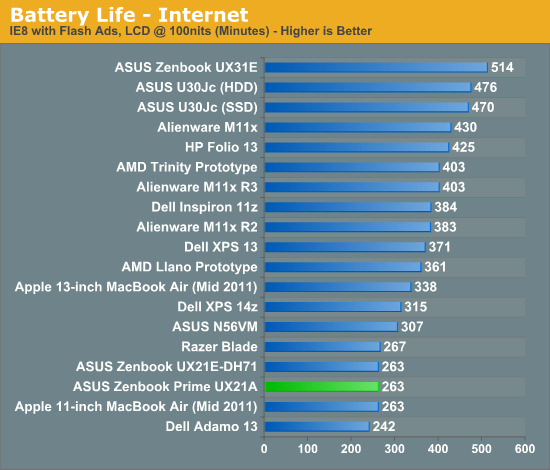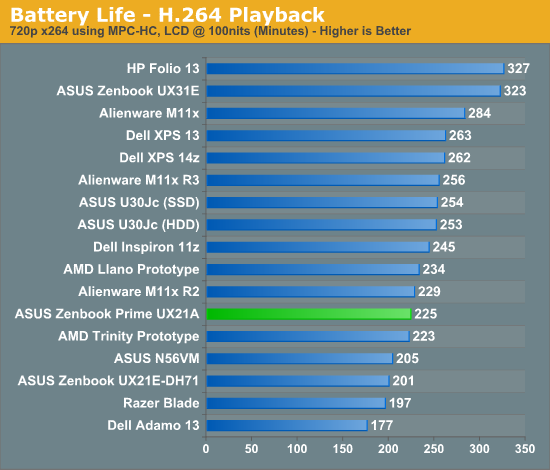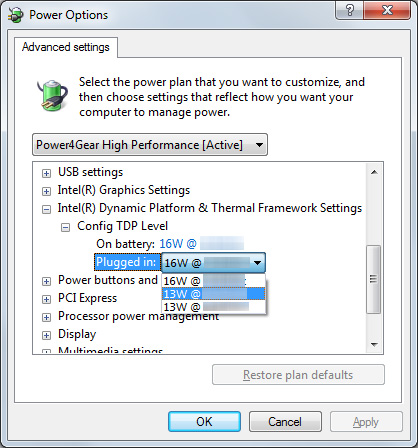ASUS Zenbook Prime (UX21A) Review: The First of the 2nd Gen Ultrabooks
by Anand Lal Shimpi on May 22, 2012 2:46 PM EST- Posted in
- Laptops
- CPUs
- Asus
- Ivy Bridge
- Zenbook
- Zenbook Prime
- Ultrabook
- Notebooks
Battery Life
Generally speaking, the 11-inch Zenbook Prime delivers about the same amount of battery life as its predecessor. For some reason we're able to hit much longer idle battery life on the Prime than the original Zenbook although I'm still trying to find out why. There's also an 11% improvement in our x264 playback test, but on average I'd expect to see similar battery life to the Sandy Bridge model - just with better performance. Note that these results also come despite the fact that ASUS is driving a much higher resolution, and presumably higher power, display than the original Zenbook.



The Zenbook Prime bucks the trend Jarred saw with the first Ivy Bridge notebook review where battery life took a small step backwards. These results bode well for future Ivy Bridge notebooks and Ultrabooks. It still remains to be seen if Intel's 22nm process will actually give us a battery life advantage in any notebook compared to its predecessor. It's possible that we are seeing some of the benefits of 22nm here already and they are simply offset by the more power hungry display. With the move to 22nm Intel should have a better hold on active power and leakage, but it's always possible that we'll have to wait until Haswell for the process to really be exploited.
Just like last time, ASUS has a couple of widgets to quickly change between power settings. The instant on widget lets you switch between suspend to RAM and suspend to disk modes. The former is expected to deliver up to 2 weeks of standby battery life, while the latter can push up to 150 days. I didn't have the time to test these claims (life is short, I draw the line at spending it testing claims of 150 day standby battery life). ASUS once again includes a counter that estimates how long your system will last in either mode based on current charge levels and power usage.
The next widget is a quick tool to let you switch between high performance and battery saver Power4Gear power profiles. You can customize these profiles via the Windows control panel, but it's nice to have a button on the desktop that lets you quickly switch between them.
Configurable TDP
One feature of Ivy Bridge that we haven't been able to test until now is configurable TDP. While most Ultrabook CPUs ship with a 17W TDP, that's mostly an arbitrary thermal/power rating. If an OEM wants to design a chassis that can only accept a 13W part it previously had to hope that Intel would make such a thing. Alternatively, the OEM could underclock/undervolt a 17W chip on their own and hope to mimic Intel's validation and deliver a 13W configuration of their own. The former requires that a significant number of OEMs demand the part, while the latter is just too risky for the larger OEMs (get too aggressive on the undervolting side and end up with a bunch of unstable systems). The solution Intel proposed with Ivy Bridge is configurable TDP. For Ultrabooks this means you can set a 17W part to 13W.

Currently the setting is hidden away in Windows 7's power management settings. Once again I've had to censor the clock speeds here due to Intel's Ultrabook embargo:
You can map the 13W settings to the battery saver profile and then, at the click of a button, have a 13W Zenbook Prime instead of a 17W model. The difference in performance isn't significant however:
| ASUS Zenbook Prime Configurable TDP Performance - Cinebench 11.5 (Multithreaded) | |||||||
| 16W - Max Freq | 13W - Mid Freq | 13W - Lowest Freq | |||||
| ASUS Zenbook Prime UX21A | 2.79 | 2.67 | 2.67 | ||||
I'm still running battery life tests to quantify the impact on power consumption, but it's conceptually a neat thing to see in action finally. I suspect configurable TDP is going to play a major role with Haswell and convertible/dockable Ultrabook-tablet hybrids.
Thermals and Noise
As with most high performance notebooks that are this thin, cooling is difficult. Under load the fans in the Zenbook Prime are definitely audible, but in general ASUS does a better job cooling everything inside the Zenbook Prime than Apple does in the MacBook Air. I suspect much of this boils down to how aggressive Apple is about keeping fan speed/noise down compared to ASUS' desire to maintain a certain temperature level inside the chassis.










192 Comments
View All Comments
rast20 - Tuesday, May 22, 2012 - link
Different IVB CPU. We can't see it (both configs only feature "ULV IVB") because it's still supposed to be secret, but I'd guess one is i5 and the other is i7.AmdInside - Wednesday, May 23, 2012 - link
The fact that it features an IPS display makes it an easy choice over a Macbook Air and I personally love both Win7 and MacOSX so it is not about OS. I wish I had not just purchased a projector or else this would be on my shopping list right now.ImSpartacus - Wednesday, May 23, 2012 - link
Over a 2011 Macbook Air, sure.I'm reserving judgment until I see the 2012 models. As Anand mentioned, ASUS wouldn't've rushed the Zenbook Prime review units if they didn't have to do it. We won't be waiting long.
cwcwfpfp - Wednesday, May 23, 2012 - link
Thanks for the thorough and insightful preview Anand. By far the most informative of all the previews/hands-ons for the UX21A I've read.I am going to add my voice to those pointing out the 4GB limit. While I think those saying 4GB won't be enough for gaming are a being unrealistic, I do think it is realistic to want more RAM options for other reasons. Right now 4GB should be just fine, but do you guys really see it being sufficient 2 years down the line? I say this as a graduate student often on the move who would like something light to carry around and do work on. So I do foresee having multiple applications running at once and would love more RAM for future-proofing.
I also have my own issues with the keyboard and touchpad layout - basically I think they went too far in borrowing elements of the MacBook Air here and suffer from form over function. Not a fan at all of the clickable touchpad - much prefer dedicated left/right buttons (and even additional buttons above the touchpad would be nice). Also would like to see dedicated page up/down keys - preferably right above the arrow keys. This is more of a personal preference though. I'm sure a fair number of people will disagree with me on that.
That said, overall the UX31A/21A looks like the ultrabook to beat right now. In fact I will likely pick up a UX31A when it comes out, despite my minor complaints above.
SignalPST - Wednesday, May 23, 2012 - link
Can you test the WiDi feature on the Prime? I've heard that version 2.0 supports 2 individual display outputs at 30fps or 1 output at 60fps.Also, since IVB supports max 3 display outputs, can you output both to the microHDMI and miniVGA, and keep the main LCD active as well?
IntelUser2000 - Wednesday, May 23, 2012 - link
I think that's with WiDi 3.0, which will likely come with updated HD Graphics drivers. WiDi 2.0 didn't come with Sandy Bridge launch, only with updated drivers.Also it says on one Ivy Bridge presentation that you can output to two additional monitors using HDMI and Displayport.
SignalPST - Thursday, May 24, 2012 - link
Hmm... you're right. Hopefully we'll get to see some of that action on the Prime.ssj4Gogeta - Wednesday, May 23, 2012 - link
"life is short, I draw the line at spending it testing claims of 150 day standby battery life"You forgot you' have to measure it three times then take the average. :-P
Pantsu - Wednesday, May 23, 2012 - link
Hopefully the 13" models won't be overpriced where I live, since this could be my next laptop. I was afraid the 1080p panel would be only available for $1500+ models.The W7 scaling is probably why most laptop manufacturers didn't want to offer 1080p option. Luckily Windows 8 should fix that issue too.
I'm still debating though whether I want an ultrabook or if I could do with a standard voltage model with discrete graphics, as long as it is lighter than my current white macbook. I don't need an optical drive or ethernet, but neither do I necessarily need the laptop to be ultra thin and light. Looks like I'll wait until back-to-school season until I make my pick though. There should be a good amount of choices available then.
ijozic - Wednesday, May 23, 2012 - link
I don't understand why Asus designs their Zenbooks pretty much like MB Airs? Personally, I find the Apple laptops' looks overly sterile so this makes the Zenbook a no choice for me (unfortunately).My biggest functional gripe with this choice is that they are copying the side profile design of the case - IMHO, if they'd made a case with a uniform thickness, they'd have had room for more ports (e.g. more USBs, SD card reader slot, maybe even a thin express card slot), plus extra battery capacity.
Also, a 1600x900 screen would seem as a more usable choice and thus it would be nice to have it as an option. Well, at least the screens are not glossy as on the Apple..